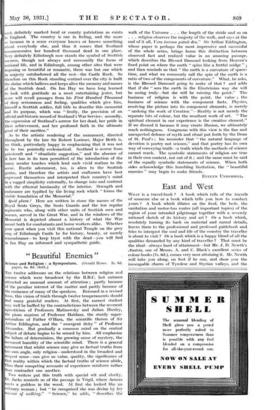East and West WHAT is a travel-book ? A book
which tells of the travels of someone else or a book which tells you how to conduct yours ? A book which dilates on the food, the beds, the sanitation and motor-bus routes (all important topics) of the region of your intended pilgrimage together with a severely rationed sketch of its history and art ? Or a book which, resolutely turning, its back on material and carnal details, leaves them to the professional and professed guidebook and tries to interpret the soul and life of the country the traveller is about to visit ? Or a book which is a happy blend of all the qualities demanded by any kind of traveller ? That must be the ideal—always hard of attainment—but Mr. J. D. Newth's Austria, one of Messrs. A. and C. Black's excellent series of colour-books (7s. 6d.), comes very near attaining it. Mr. Newth will take you along, on foot if he can, and show you the inescapable charm of Tyrolese and Styrian valleys, and the
dreaming lakes of Carinthia where the sun shines for eighteen weeks together and rain is not. Ile will try to make you like the baroque in Austrian architecture and tell you where to dine in Vienna ; and it will not be his fault if you do not fall in love with the hospitable, friendly, carefree people and with all that is included in that untranslatable word gentittlichkeit. From Austria it is no far cry to Central Germany which Mr. Malcolm Letts, author of A Wayfarer in Central Germany (Methuen, 7s. 6d.), defines as the area included by Miinster and Magdeburg on the north and by Coblenz and Jena on the south. The "Wayfarer" series has already made its name for sound information quietly conveyed, and this youngest mem- ber of it well maintains its reputation. Among the hills of the Thuringian Forest there is good walking—even a golf- course if woods and half-timbered houses bore the visitor— and Mr. Letts strongly advises him to see Naumburg Cathedral, which contains some of the finest thirteenth-century sculpture in Germany.
If Spain unduly neglects publicity, as Mrs. Clara E. Laughlin (of Chicago) says she does, then in So You're going to Spain ? (Methuen, 10s. 6d.) the author gives her plenty in the shape of quantities of pemmicanized information of every kind and is able to inform motorists that Spanish roads are in general very good. To the sharp-cut sierras, fierce blue sky and luxuriant architecture of Spain the strongest contrast is presented by the bleak, boulder-strewn and lake-studded expanse of Finland. Not many people go there, save for fishing, but for those who wish to Mr. Kay Gilmour's Finland (Methuen, Cis.) gives a plain succinct account of the country's life, industries and features of interest. The author notes that Helsinki (which is Helsingfors) is a city without slums and with no housing problem, and how that solution has been attained is well worth the attention of those interested in such matters.
We move much farther afield in Mr. Hendrik de Leeuw's Crossroads of the Java Sea (Cape, 15s.), which is devoted to a description of the great Dutch Indies—probably the richest tropical empire in the world—Borneo, Java, Sumatra, Bali and Celebes. The author mentions in his preface his wish produce a travel-book from which one can learn something," and from his work one does learn much, acquiring from one book information about life, industry, social customs and superstition, which otherwise would have to be sought in many. Perhaps there is a little too much amateur anthro- pology in the volume, a sort of Frazer and water, which some. times goes rather far for the general reader and not far enough for the serious student. But Mr. de Leeuw certainly achieves his object of imparting information, especially about Celebes, of which little has been written in English. It is curious though that the bibliography contains no mention of Guille- mard's Cruise of the Marchesa, which has much to say about that queer-shaped island.
Some of the history and much of the geography of South America are set out in Mr. C. W. Townsend's From Panama to Patagonia (Witherby, 12s. 6d.), but he went further than that, for the sea took him on as far as Rio. As he travelled from port to port he landed occasionally to make detours into the interior—to Quito which enjoys an everlasting spring among the highlands of Ecuador, to the old Inca capital of Cuzco in Peru, and to the rather commonplace town of La Paz in Bolivia, where he escaped the periodical revolution or petty war, but noticed a poster still clinging to a wall which announced that Morir par la Patria es deber de todo Boliviano. Which is very well, but in general that duty is forced on the other fellow. His most extended land-journey by train up to Asuncion, lay through the rich Entre Rios province of the Argentine, the country of Hudson's Far Away and Long Ago. The book furnishes a good picture of the aspect, and life of these well-known but widely differing regions.







































 Previous page
Previous page